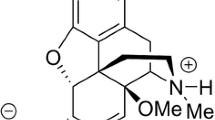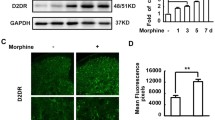Abstract
Purpose
Morphine is an effective analgesic, but adverse effects limit its clinical use in higher doses. The non-opioid antitussive, dextromethorphan (DM), can potentiate the analgesic effect of morphine and decrease the dose of morphine in acute postoperative pain, but the underlying mechanism remains unclear. We previously observed that DM increases the serum concentration of morphine in rats. Therefore, we investigated the effects of drugs administered at the spinal level to exclude possible pharmacokinetic interactions. As DM has widespread binding sites in the central nervous system [such as N-methyl-D-aspartate (NMDA) receptors, sigma receptors and α3ß4 nicotinic receptors], we investigated whether the potentiation of morphine antinociception by DM at the spinal level is related to NMDA receptors.
Methods
We used MK-801 as atool to block the NMDA channel first, and then studied the interaction between intrathecal (i.t.) morphine and DM. The tail-flick test was used to examine the antinociceptive effects of different combinations of morphine and other drugs in rats.
Results
DM (2–20 μg) or MK-801 (5–15 μg) showed no significant antinociceptive effect by themselves. The antinociceptive effect of morphine (0.5 μg, i.t.) was significantly enhanced by DM and reached the maximal potentiation (43.7%–50.4%) at doses of 2 to 10 μg. Pretreatment with MK-801 (5 or 10μg, i.t.) significantly potentiated morphine antinociception by 49.9% or 38.7%, respectively. When rats were pretreated with MK-801, DM could not further enhance morphine antinociception (45.7%vs 50.5% and 43.3%).
Conclusion
Our results suggest that spinal NMDA receptors play an important role in the effect of DM to potentiate morphine antinociception.
Résumé
Objectif
Analgésique efficace, la morphine a cependant des effets indésirables qui en limite l’usage clinique à fortes doses. L’antitussif, dextrométhorphane (DM), peut augmenter l’effet analgésique de la morphine et permettre d’en utiliser une dose postopératoire plus faible, mais le mécanisme responsable de cette action est encore inconnu. Nous savons que le DM augmente la concentration sérique de la morphine chez les rats. Nous avons donc voulu explorer les effets de médicaments administrés au niveau rachidien afin d’exclure des interactions pharmacocinétiques possibles. Les sites de fixation du DM étant nombreux dans le système nerveux central [comme les récepteurs N-méthyl-D-aspartate (NMDA), les récepteurs sigma et les récepteurs nicotiniques α3ß4], nous avons vérifié si la potentialisation de l’antinociception de la morphine par le DM au niveau rachidien est reliée aux récepteurs NMDA.
Méthode
Nous avons utilisé le MK-801 pour bloquer d’abord le canal NMDA et étudier ensuite l’interaction entre la morphine intrathécale (i.t.) et le DM. Le test de latence de rétraction de la queue a été utilisé pour vérifier les effets antinociceptifs de différentes combinaisons de morphine et d’autres médicaments chez les rats.
Résultats
Le DM (2– 20 μg) ou le MK-801 (5– 15 μg) n’ont montré aucun effet antinociceptif significatif par euxmêmes. L’effet antinociceptif de la morphine (0,5 μg, i.t.) a été significativement accru par le DM et a atteint sa potentialisation maximale (43,7 % –50,4 %) aux doses de 2 à 10 μg. Un prétraitement avec MK-801 (5 ou 10 μg, i.t.) a significativement augmenté l’effet antinociceptif de la morphine de 49,9% ou de 38,7 %, respectivement. Chez les rats prétraités avec MK-801, le DM ne pouvait augmenter davantage l’antinociception de la morphine (45,7% vs 50,5% et 43,3%). Conclusion : Nos résultats indiquent que les récepteurs NMDA jouent un rôle important dans l’effet de potentialisation de l’antinociception de la morphine par le DM.
Similar content being viewed by others
References
Tao PL, Yeh GC, Su CH, Wu YH. Co-administration of dextromethorphan during pregnancy and throughout lactation significantly decreases the adverse effects associated with chronic morphine administration in rat offspring. Life Sci 2001; 69: 2439–50.
Mao J, Price DD, Caruso FS, Mayer DJ. Oral administration of dextromethorphan prevents the development of morphine tolerance and dependence in rats. Pain 1996; 67: 361–8.
Yeh GC, Tao PL, Chen JY, Lai MC, Gao FS, Hu CL. Dextromethorphan attenuates morphine withdrawal syndrome in neonatal rats passively exposed to morphine. Eur J Pharmacol 2002; 453: 197–202.
Trujillo KA, Akil H. Inhibition of morphine tolerance and dependence by the NMDA receptor antagonist MK-801. Science 1991; 251: 85–7.
Elliott K, Minami N, Kolesnikov YA, Pasternak GW, Inturrisi CE. The NMDA receptor antagonists, LY274614 and MK-801, and the nitric oxide synthase inhibitor, NG-nitro-L-arginine, attenuate analgesic tolerance to the mu-opioid morphine but not to kappa opioids. Pain 1994; 56: 69–75.
Elliott K, Hynansky A, Inturrisi CE. Dextromethorphan attenuates and reverses analgesic tolerance to morphine. Pain 1994; 59: 361–8.
Su MT, Lin WB, Lue WM, Cheng CY, Tao PL. Blockade of the development of morphine tolerance by U-50,488, an AVP antagonist or MK-801 in the rat hippocampal slice. Br J Pharmacol 1998; 123: 625–30.
Manning BH, Mao J, Frenk H, Price DD, Mayer DJ. Continuous co-administration of dextromethorphan or MK-801 with morphine: attenuation of morphine dependence and naloxone-reversible attenuation of morphine tolerance. Pain 1996; 67: 79–88.
Wong CS, Liaw WJ, Tung CS, Su YF, Ho ST. Ketamine potentiates analgesic effect of morphine in postoperative epidural pain control. Reg Anesth 1996; 21: 534–41.
Klein M, Musacchio JM. High affinity dextromethorphan binding sites in guinea pig brain. Effect of sigma ligands and other agents. J Pharmacol Exp Ther 1989; 251: 207–15.
Hernandez SC, Bertolino M, Xiao Y, Pringle KE, Caruso FS, Kellar KJ. Dextromethorphan and its metabolite dextrorphan block alpha3beta4 neuronal nicotinic receptors. J Pharmacol Exp Ther 2000; 293: 962–7.
Craviso GL, Musacchio JM. High-affinity dextromethorphan binding sites in guinea pig brain. II. Competition experiments. Mol Pharmacol 1983; 23: 629–40.
Steinberg GK, Bell TE, Yenari MA. Dose escalation safety and tolerance study of the N-methyl-D-aspartate antagonist dextromethorphan in neurosurgery patients. J Neurosurg 1996; 84: 860–6.
Wong CS, Wu CT, Yu JC, Yeh CC, Lee MM, Tao PL. Preincisional dextromethorphan decreases postoperative pain and opioid requirement after modified radical mastectomy. Can J Anesth 1999; 46: 1122–6.
Kawamata T, Omote K, Kawamata M, Namiki A. Premedication with oral dextromethorphan reduces postoperative pain after tonsillectomy. Anesth Analg 1998; 86: 594–7.
Chia YY, Liu K, Chow LH, Lee TY. The preoperative administration of intravenous dextromethorphan reduces postoperative morphine consumption. Anesth Analg 1999; 89: 748–52.
Weinbroum AA, Rudick V, Paret G, Ben-Abraham R. The role of dextromethorphan in pain control. Can J Anesth 2000; 47: 585–96.
Hoffmann O, Wiesenfeld-Hallin Z. Dextromethorphan potentiates morphine antinociception, but does not reverse tolerance in rats. Neuroreport 1996; 7: 838–40.
Baker AK, Hoffmann VL, Meert TF. Dextromethorphan and ketamine potentiate the antinociceptive effects of μ-but not δ-or κ-opioid agonists in a mouse model of acute pain. Pharmacol Biochem Behav 2002; 74: 73–86.
Grass S, Hoffmann O, Xu XJ, Wiesenfeld-Hallin Z. N-methyl-D-aspartate receptor antagonists potentiate morphine’s antinociceptive effect in the rat. Acta Physiol Scand 1996; 158: 269–73.
Church J, Lodge D, Berry SC. Differential effects of dextrorphan and levorphanol on the excitation of rat spinal neurons by amino acids. Eur J Pharmacol 1985; 111: 185–90.
Wong CS, Hsu MM, Chou YY, Tao PL, Tung CS. Morphine tolerance increases [3H]MK-801 binding affinity and constitutive neuronal nitric oxide synthase expression in rat spinal cord. Br J Anaesth 2000; 85: 587–91.
D’Amour FE, Smith DL. A method for determining loss of pain sensation. J Pharmacol Exp Ther 1941; 72: 74–9.
Schmitt B, Netzer R, Fanconi S, Baumann P, Boltshauser E. Drug refractory epilepsy in brain damage: effect of dextromethorphan on EEG in four patients. J Neurol Neurosurg Psychiatry 1994; 57: 333–9.
Price DD, Mao J, Frenk H, Mayer DJ. The N-methyl-D-aspartate receptor antagonist dextromethorphan selectively reduces temporal summation of second pain in man. Pain 1994; 59: 165–74.
Choi DM, Kliffer AP, Douglas MJ. Dextromethorphan and intrathecal morphine for analgesia after caesarean section under spinal anaesthesia. Br J Anaesth 2003; 90: 653–8.
Caruso FS. MorphiDex® pharmacokinetic studies and single-dose analgesic efficacy studies in patients with postoperative pain. J Pain Symptom Manage 2000; 19: S31–6.
Author information
Authors and Affiliations
Corresponding author
Additional information
This study was supported by grants from the National Health Research Institutes (NHRI-EX92-8909BP) and the Taipei Veterans General Hospital (92-V313), Taipei, Taiwan.
Rights and permissions
About this article
Cite this article
Chow, LH., Huang, E.Y.K., Ho, ST. et al. Dextromethorphan potentiates morphine antinociception at the spinal level in rats. Can J Anesth 51, 905–910 (2004). https://doi.org/10.1007/BF03018888
Accepted:
Published:
Issue Date:
DOI: https://doi.org/10.1007/BF03018888




